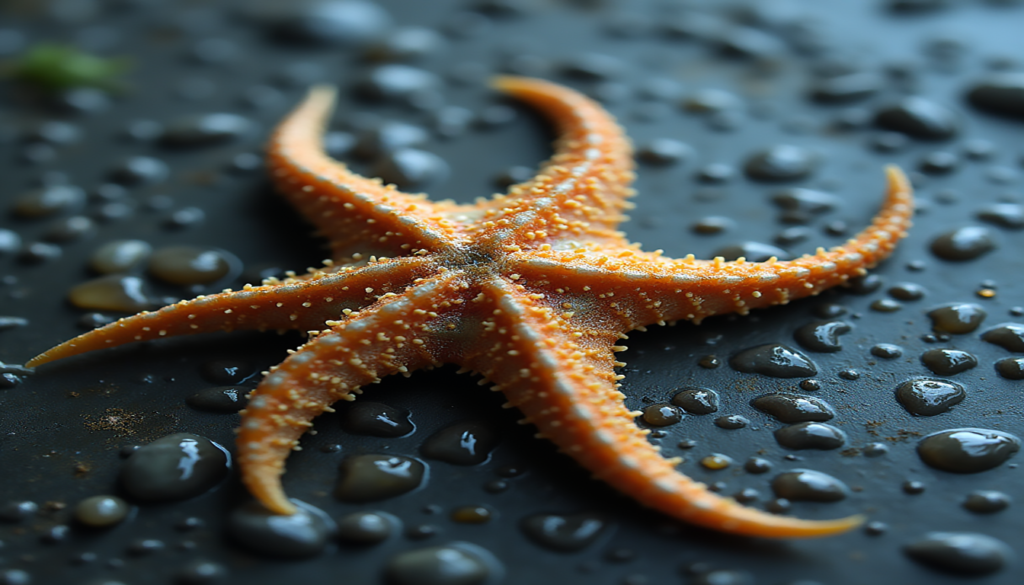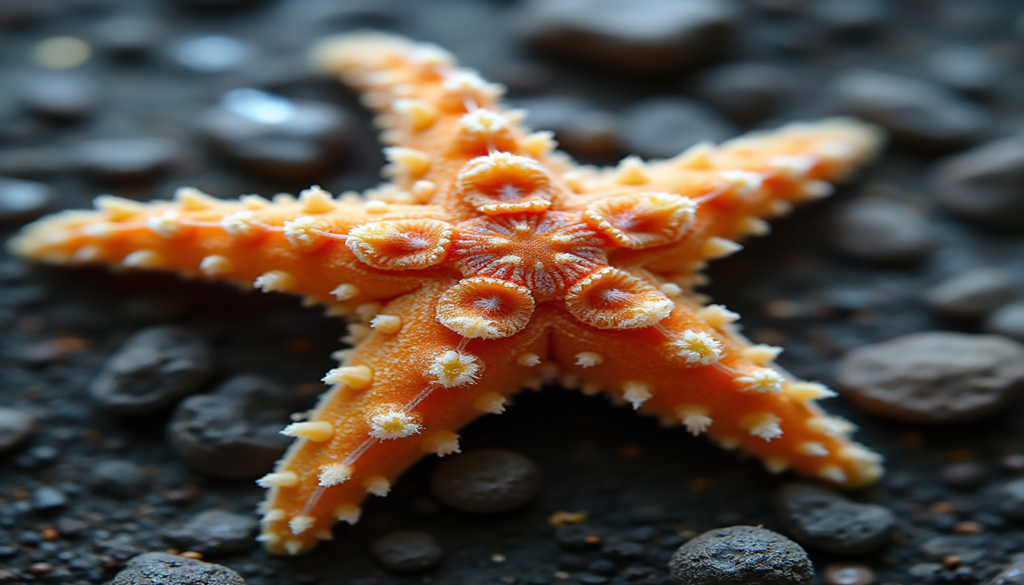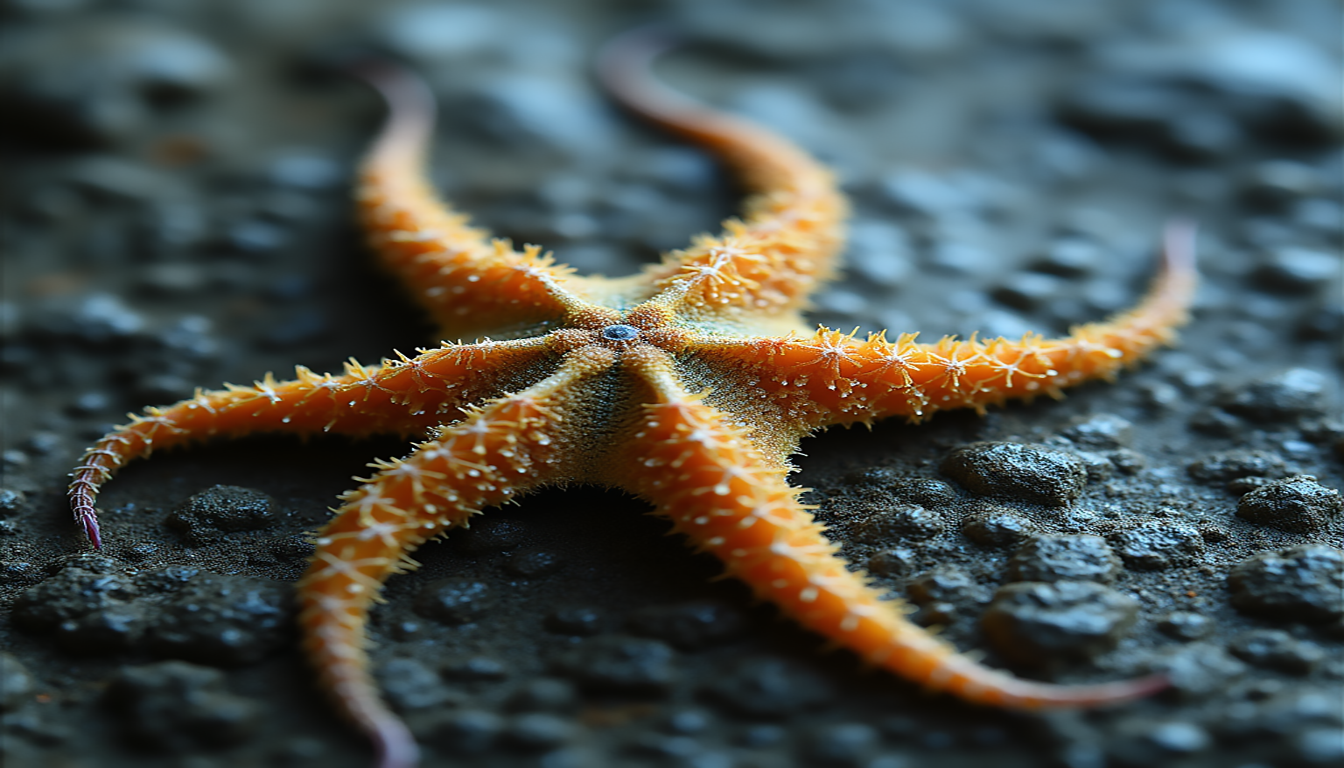
Dive into the world of marine life and discover the amazing growth of brittle stars. These creatures have been perfecting their survival for over 150 million years. They are true champions of adaptation in the ocean.
Exploring how long a brittle star arm can grow reveals a biological marvel. Brittle stars can regrow lost limbs. Some can even grow a whole body from just one arm.
Marine biologists are fascinated by brittle stars. Their ability to regrow arms shows their incredible resilience. Learning about brittle star arm length helps us understand their amazing adaptations.
Table of Contents
Introduction to Brittle Stars: Ancient Marine Creatures
Explore the world of brittle stars, deep-sea wonders that have lived in our oceans for over 500 million years. These marine invertebrates are part of the echinoderm family. They share a common ancestor with starfish but have their own special traits.
What Makes Brittle Stars Different from Starfish
Brittle stars and starfish are quite different. Brittle stars have flexible arms that let them move quickly on the ocean floor. Their anatomy is unique, with:
- More slender and distinct arms
- Greater mobility and speed
- Complex arm articulation
- Advanced sensory capabilities
Historical Evolution of Brittle Stars
Echinoderms have a long and fascinating history. With about 7,000 species in the sea, they show amazing adaptability. They have radial symmetry, with five or more arms.
Some brittle stars can regenerate up to 75% of their body mass, showing nature’s incredible resilience.
Basic Anatomy Overview
| Anatomical Feature | Description |
|---|---|
| Central Disk | Central body where arms connect |
| Arms | Flexible, can move independently |
| Skeletal System | Internal calcium carbonate plates |
| Movement Method | Unique arm-based locomotion |
Learning about these ancient sea creatures helps us understand nature’s adaptability and resilience. Their detailed anatomy continues to intrigue marine biologists and ocean lovers everywhere.
How Long Can an Arm of a Brittle Star Grow
Brittle stars have amazing arm growth abilities. Their arm length can grow a lot, thanks to several interesting factors. These marine animals are truly unique.
Factors Affecting Arm Growth
Several key things affect how long a brittle star’s arm can grow:
- Species-specific genetic characteristics
- Environmental conditions
- Nutritional availability
- Age of the individual brittle star
Maximum Growth Potential
The length of a brittle star’s arm varies by species. Some can grow arms up to 60 centimeters (24 inches) long. This shows their amazing growth potential.
“The adaptive capabilities of brittle stars demonstrate nature’s remarkable engineering.” – Marine Biology Research Institute
Growth Rate Variables
| Growth Factor | Impact on Arm Length |
|---|---|
| Genetic Variation | High influence on maximum arm length |
| Ocean Depth | Moderate impact on growth rate |
| Nutritional Conditions | Critical for sustained arm development |
| Regeneration Capability | Allows continuous arm reconstruction |
Brittle stars grow their arms in a special way. About 90% of them can regrow their arms. This can take weeks to months, depending on their environment.
Now you know more about brittle star arm length. These creatures show how adaptable and resilient life can be in the ocean.
The Remarkable Process of Arm Regeneration
Brittle star regeneration is one of the most amazing facts in the sea. These creatures can grow back lost arms. This makes them experts at surviving in tough marine environments.
The process of regrowing arms in brittle stars is very complex. It helps them heal quickly from injuries. Scientists found that over 90% of wild brittle stars can grow back lost limbs. This is a key survival strategy for them.
“Nature’s most remarkable healing ability lies within the brittle star’s extraordinary regenerative power.” – Marine Biology Research Institute
Here’s how brittle star arm regeneration works:
- Initial wound sealing occurs within 48 hours of arm loss
- Specialized cells begin rapid tissue reconstruction
- New arm structures develop from the remaining body segment
- Complete regeneration can take several weeks to months
The genetic basis for this ability is in the brittle star’s complex genome. They have 30,267 protein-coding genes and special genes for wound healing. This makes them very good at regrowing their arms.
Researchers studying the Amphiura filiformis species found something amazing. Brittle stars can not only regrow arms but also use arm fragmentation for asexual reproduction. This unique ability makes them stand out from other sea creatures.
Brittle star regeneration continues to fascinate marine biologists, offering insights into cellular regeneration and evolutionary survival mechanisms.
Brittle Star Anatomy: A Closer Look at Their Structure
Dive into the fascinating world of brittle star anatomy. These remarkable deep-sea creatures have an extraordinary biological design. Unlike typical marine organisms, brittle stars have unique features that help them survive in challenging ocean environments.

Central Disk: The Command Center
The central disk of a brittle star is its critical hub. It’s usually between 3 to 8 inches in diameter. This small area houses essential organs and coordinates the creature’s complex movements.
- Contains mouth and digestive system
- Hosts primary neural networks
- Provides structural support for five arms
Arm Construction and Specialized Functions
Brittle star arms are engineering marvels of marine biology. Made of many articulated calcium carbonate plates, these arms allow for incredible flexibility and movement in deep-sea creatures.
| Arm Characteristic | Description |
|---|---|
| Length | Up to 60 cm in largest species |
| Movement | Powered by intrinsic arm muscles |
| Key Function | Locomotion and feeding |
Skeletal System: A Marvel of Marine Engineering
The skeletal system of brittle stars is a sophisticated adaptation. Made from interconnected calcium carbonate plates, it offers unmatched flexibility while maintaining structural integrity.
“The brittle star’s skeletal structure is nature’s perfect balance between strength and adaptability.” – Marine Biology Research Institute
Understanding brittle star anatomy shows why these marine organisms have thrived for millions of years. They continually adapt to complex underwater environments.
Habitat and Distribution Across Ocean Depths
Brittle stars are amazing creatures that live in many parts of the ocean. They can be found in both shallow waters and deep down, up to 6,000 meters (20,000 feet). These marine animals have learned to live in a wide range of underwater places.
Brittle stars are found in different marine environments. You can find them in:
- Rocky reefs
- Coral reef systems
- Sandy ocean bottoms
- Seagrass meadows
- Deep-sea environments
Each brittle star species has its own special way of living. Some like the warm, shallow waters of the tropics. Others prefer the dark, deep sea.
“The ocean is a world of remarkable diversity, and brittle stars are masters of adaptation.” – Marine Biologist Dr. Elena Rodriguez
About 30% of brittle stars live in the deep sea, below 200 meters. Their arms can be very small or very long, up to 60 centimeters (24 inches). This shows how diverse and successful they are.
These deep-sea creatures are very important to the ocean. They help move nutrients around and keep the balance of smaller sea animals. This makes them key players in the ocean’s ecosystem.
Reproduction Methods: From Cloning to Sexual Reproduction
Brittle stars have unique ways of reproducing, showing how amazing marine life can be. They have special methods that make them stand out from other sea creatures.

These sea stars use two main ways to make more of themselves: asexual and sexual reproduction. Learning about these methods helps us understand how they survive and adapt.
Asexual Reproduction Through Fragmentation
One cool thing about brittle stars is how they can make new ones by breaking apart. Here’s how it works:
- They can break off a part of their arm.
- Then, they can grow a whole new star from that piece.
- This new star is a clone of the original.
Sexual Reproduction Cycles
Sexual reproduction in brittle stars is quite complex. Most of them spawn at the same time. This means males and females release their reproductive cells into the water together.
“Nature’s most intricate reproductive dance occurs in the depths of our oceans” – Marine Biologist
Larval Development Stages
After they’re fertilized, brittle stars go through some amazing changes. Their young, called ophiopluteus, float in the ocean currents. Eventually, they settle down and grow into adult stars.
The ability of marine invertebrates to use stem cells makes these reproductive processes possible. This allows brittle stars to regenerate and reproduce very efficiently.
Feeding Habits and Survival Strategies
Brittle stars are fascinating marine creatures with unique feeding strategies. They have developed ways to survive in different ocean environments.
Their feeding mechanisms are truly extraordinary. Brittle stars use several strategies to get nutrients:
- Filtering small particles from water currents
- Scavenging organic detritus on the seafloor
- Capturing small marine organisms using their flexible arms
- Opportunistic predation on immobile prey
The marine life facts about brittle stars show their incredible adaptability. Their arms serve multiple functions – not just for movement, but also as sophisticated feeding tools. Some species use their tube feet to create tiny water currents, drawing microscopic food particles directly to their mouth.
“Brittle stars are the ultimate survivors of the marine world, turning every challenge into an opportunity for nutrition.” – Marine Biology Research Institute
Different brittle star species have evolved unique feeding adaptations. Deep-sea varieties might rely more on filter feeding, while shallow water species often engage in active hunting. Their ability to quickly detect and respond to food sources demonstrates their exceptional survival strategies.
Understanding these intricate feeding habits provides crucial insights into the ecological roles of these remarkable marine creatures.
Defense Mechanisms and Predator Interactions
Brittle stars have developed amazing ways to survive in the ocean. They use special defense mechanisms to protect themselves from predators.
These marine creatures have evolved incredible adaptations. One of their best defenses is arm autotomy. This lets them detach limbs when threatened.
Arm Autotomy: A Survival Technique
When faced with predators, brittle stars can shed their arms. This survival tactic has several benefits:
- Distracts potential predators
- Creates an opportunity for escape
- Allows for rapid arm regeneration
Predator Avoidance Techniques
Besides arm autotomy, brittle stars have other defenses:
- Camouflage techniques
- Quick movement across sea floors
- Hiding in coral reef crevices
“Nature has equipped brittle stars with ingenious survival mechanisms that demonstrate the remarkable adaptability of marine life.” – Marine Biology Research Institute
| Defense Mechanism | Effectiveness | Primary Purpose |
|---|---|---|
| Arm Autotomy | High | Predator Distraction |
| Camouflage | Medium | Concealment |
| Rapid Movement | High | Immediate Escape |
Learning about these defenses shows how brittle stars have adapted to survive. Their strategies help them thrive in tough marine environments.
Environmental Adaptations and Survival Skills
Brittle stars are amazing creatures that live in the deep sea. They have special ways to survive in tough marine environments. These echinoderms can live in many places, from shallow reefs to deep-sea habitats.
They have unique survival skills:
- Exceptional flexibility in arm movement
- Advanced sensory capabilities
- Rapid regeneration of lost body parts
- Specialized locomotion techniques
In the deep ocean, brittle stars have amazing features. Their skeletal structure lets them move through complex terrains with great precision. They can quickly react to changes in their environment. This helps them avoid predators.
“Nature’s design of brittle stars represents an extraordinary example of evolutionary adaptation” – Marine Biology Research Institute
Brittle stars can regrow lost parts of their bodies. This is a big advantage in the unpredictable sea. It helps them recover from attacks and keep thriving in tough places.
Conservation Status and Environmental Threats
Brittle stars are vital to marine life, facing big environmental challenges. These challenges threaten their homes in the ocean. Many brittle star species are still alive, but they face big dangers from human actions.
The main dangers to their homes include:
- Ocean acidification messing with ocean chemistry
- Habitat loss from coastal development
- Warmer water from global warming
- Pollution from factories and farms
Scientists have seen big drops in some sea star populations. For example, some sea stars have lost up to 83.3% of their individuals in a few years.
“Protecting marine ecosystems is crucial for the survival of brittle stars and the overall health of our oceans.” – Marine Conservation Research Team
There are efforts to save these amazing creatures. Research groups are working hard to keep an eye on and protect brittle star populations in different ocean places.
| Environmental Threat | Impact on Brittle Stars | Conservation Status |
|---|---|---|
| Ocean Acidification | High vulnerability | Moderate risk |
| Habitat Destruction | Significant population disruption | Critical concern |
| Water Temperature Changes | Potential reproductive challenges | Ongoing monitoring |
You can help save brittle stars by supporting ocean research, cutting down on carbon, and telling others why we need to protect the sea.
Conclusion
Exploring how long an arm of a brittle star can grow shows us a fascinating world. These creatures can grow back and survive in tough ocean conditions. Their ability to do this gives scientists a deep look into how marine life grows and survives.
Learning about brittle stars takes us into their complex world. Their arms can grow back, showing nature’s amazing design. This design includes special tendons and properties that help them regenerate. Facts about brittle stars show how they have thrived in different ocean environments.
Scientists keep studying these ancient sea creatures. They want to learn more about their biology and how they fit into the ocean’s diversity. By protecting their homes and supporting research, we help these unique creatures thrive in our oceans.
Thinking about brittle stars reminds us of nature’s incredible abilities. Each arm of theirs teaches us about resilience and how to survive in the ocean. Their ways of living show us the importance of balance in marine ecosystems.
FAQ
How long can a brittle star’s arm grow?
Brittle star arm length varies by species. Some can reach up to 2 feet (60 cm) long. Their arm length is influenced by habitat, age, and environment.
Are brittle stars different from starfish?
Yes, they are different. Brittle stars have flexible, snake-like arms and move fast. Their central disk is smaller, and they have better arm movement than starfish.
Can brittle stars regenerate their arms?
Absolutely! They can regrow lost arms. This is not just for survival but also for reproduction. Some can regrow an entire arm in weeks or months.
Where do brittle stars typically live?
They live in all marine environments. From shallow waters to the deepest ocean floors. They thrive in coral reefs, rocky seafloors, and deep-sea environments.
How do brittle stars move?
They move with their flexible arms and tube feet. This allows them to crawl quickly across the ocean floor. Their movement is agile and efficient.
What do brittle stars eat?
They have different eating habits. Some are predators, while others are scavengers or filter feeders. They use their arms and tube feet to catch food.
How do brittle stars defend themselves?
They have several defense strategies. They can detach an arm to escape predators. This arm can then regrow. They also use camouflage and hiding to avoid threats.
How do brittle stars reproduce?
They reproduce sexually and asexually. Sexual reproduction involves spawning. Asexual reproduction happens through fragmentation, where they split to create clones.

